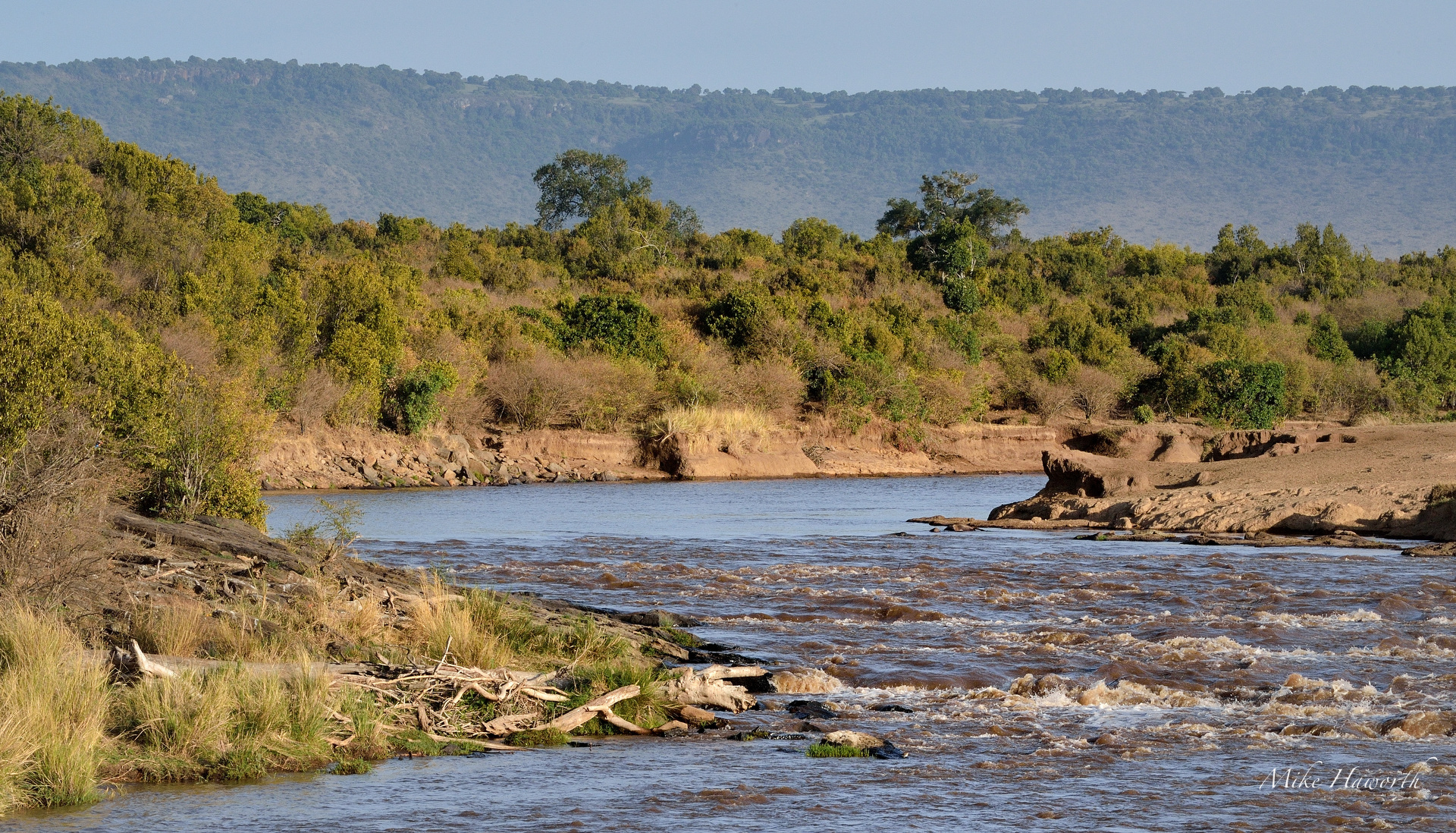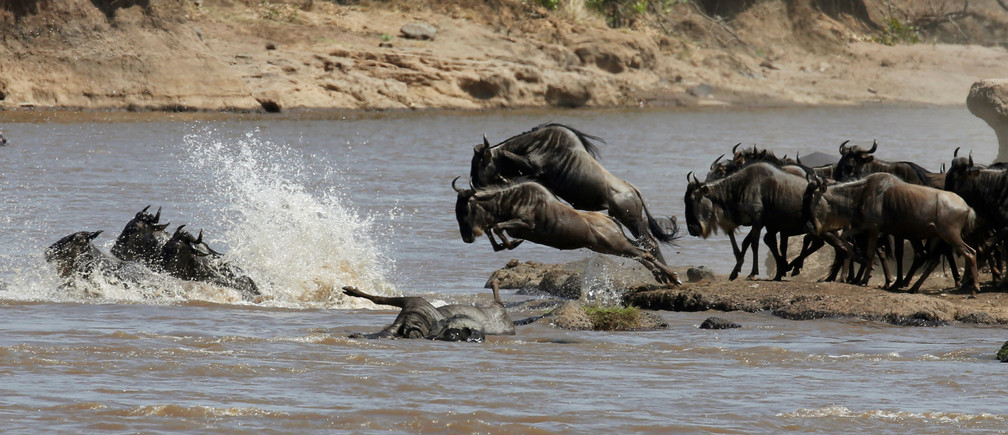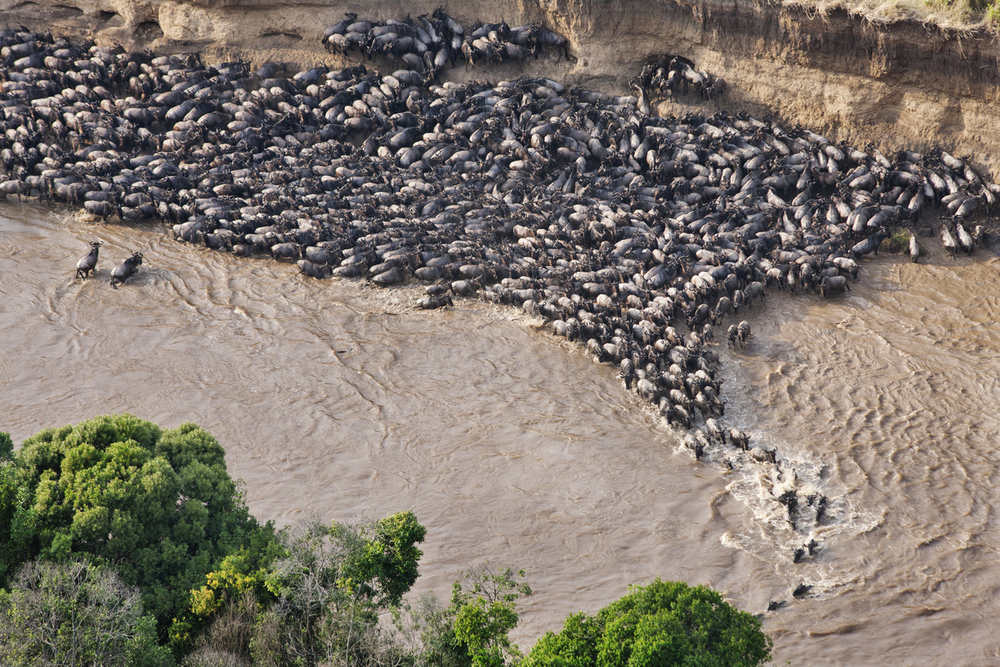Mara River is one of the arenas where the huge migration spectacle takes place and where the most popular social media images of wildebeest migrations are taken. The Mara River is renowned as “the river of death” because of its terrible participation in the Great Migration. Thousands of wildebeest race through Mara’s steep banks each year, plunging into the dangerous waters below.

The Mara River flows through southern Kenya’s Narok and northern Tanzania’s Mara Region. Before draining into Lake Victoria, the river runs from the Kenyan highlands through the Maasai Mara plains in southern Kenya and the northern Serengeti National Park in Tanzania. The Mara River is 395 kilometers long, with a basin size of 13,504 kilometers.
Most people associate the “Great Migration” with the iconic wildebeest river crossings that occur on the big two rivers, the Mara and its younger sister, the Grumeti. Wildebeest and other plains game follow the rains from the east of the Serengeti down through the north-west of Ngorongoro Conservation Area, back up through the central and west of the Serengeti, all the way up north to the Maasai Mara, and then back down through the center and east of the Serengeti.
WILDLIFE AT THE MARA RIVER
The iconic wildebeest crossing on the Mara River is a dramatic spectacle that has been featured in numerous wildlife documentaries. In these murky waterways, hippos abound, as do enormous Nile crocodiles, lurking just beneath the surface. Elephants, elands, lions, and even leopards have been known to drink from this river. If you’re lucky, you might see another rare/ endangered member of the big fives- black rhino.

THE GREAT MIGRATION ACROSS THE MARA RIVER
The Ndutu Plains and the Ngorongoro Conservation Area are where the Great Migration begins in Tanzania’s south. 500,000 wildebeest calves are born over a six-week period in the early months of the year, right after the short rains. As the plains begin to dry up, wildebeest and other grazing mammals migrate north in a clockwise path into the Serengeti, where they are hunted by predators such as lions, crocodiles, and leopards.
There’s plenty of action throughout the annual Great Migration, with calving season running from January to March, rutting season running from April to May, and river crossing season running from June to October, with the herd continuing to migrate south in November and December only to repeat the cycle. The river crossings are considered by most travelers to be the most exciting and desirable portion of the Great Migration to experience and are a must-do activity in your Serengeti safari. During the Great Migration, approximately 6,000 wildebeest die each year especially during the river crossing, providing an important food source for predators and fish. Seeing the Great Migration along the Mara River is an once-in-a-lifetime opportunity. The stunning river crossings are thrilling to see, but you’ll need patience to see them up close when they are struggling to escape from dangerous and hungry crocodiles. Wildebeest can take anything from hours to days to traverse the Mara from Tanzania’s Serengeti to Kenya’s Maasai Mara.
However, going first is a frightening proposition, as there are predators to be aware of, including crocodiles in the river and lions and other large cats waiting on the other side of the river to prey on the weaker members of the herd. There’s the muddy riverbed to avoid getting stuck in, and some sides of the ravine prove too steep to climb, forcing the herd back across the treacherous river to begin the exercise all over again. Finally, one brave wildebeest makes the first step, or rather jump, into the river, setting off a cascading movement of the entire herd one after the other in a synchronized effect, a must-see spectacle.
WHY DO WILDEBEEST CROSS THE MARA RIVER?
You should know that wildebeest migrate along the same route every year so that they do not get lost. Therefore, if you observe them crossing the river today, know that they will pass through the same route tomorrow or on the next trip. The rains are followed by the wildebeest by watching the rain clouds move. They know that when it rains a lot, the grass they eat will grow quickly. They are driven by instinct to follow the storm clouds as they cross the rivers.
HOW TO GET TO THE MARA RIVER?
It is simple to travel to the Mara River and see this world-class challenging match between the wildebeest, the river, and the most ravenous predators , such as crocodiles. The Serengeti National Park provides access to the Mara River, Several airstrips provide flights to the Serengeti, and the park itself has an airfield. Flights arrive at Seronera Airstrip from all across Tanzania, including Dar es Salaam, Arusha, Zanzibar, Kilimanjaro, and Ruaha National Park.
Road transport is another option for getting to the Mara River-Serengeti. The 8-hour road trip from Arusha to the Serengeti is a safari experience in and of itself; you’ll see plenty of wildlife and gorgeous scenery while traveling along a somewhat bumpy route. You’ll pass through the Ngorongoro Conservation Area on your way to the Serengeti, so you may wish to rest here overnight and resume the trip the next day after a three-hour drive.
WHEN TO VISIT THE MARA RIVER?
According to the Great Migration’s cycle, the best time to visit the Mara River is from July to September. The timing of the migration, however, is unpredictable, and there is no certainty that it will occur during your stay at this time. Because the Great Migration coincides with the area’s overall peak hunting season, you’ll encounter lots of wildlife regardless of whether you see the crossing. Don’t be concerned, if you can’t make it to the Mara River, the Grumeti River crossing, which occurs outside of peak season in a 1-2 week window between May and June, is another terrific way to see this amazing migratory spectacle.

WHERE TO STAY AROUND THE MARA RIVER?
Unlike her younger sister, the Grumeti River, which has limited lodging alternatives, the Mara River, while lacking in accommodations, is at least comparable to the Grumeti River. Only a few lodges are permanently located near the river, and several mobile tented camps provide temporary accommodation during the peak window of the Great Migration’s . However, keep in mind that prices will rise during the peak months, making finding affordable lodging difficult.
Some of the accommodations available at the Mara river includes Singita Mara River Camp: One of the few permanent tented camps in the area, the Mara River Camp is certain to offer you luxury and comfort, as well as wonderful access to the river. The resort is environmentally friendly and works entirely on solar power; another choice is Acacia Migration Camp, which is on the lower end of the budget range for this area and offers simple but comfortable accommodations. Other lodges offering lodging during your visit to this region of the Serengeti when seeing the river crossing spectacle include Lemala Kuria Hills Lodge, Lemala Camp, and Taasa Lodge.


